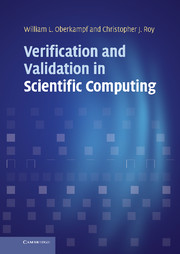Book contents
- Frontmatter
- Contents
- Preface
- Acknowledgments
- 1 Introduction
- Part I Fundamental concepts
- Part II Code verification
- Part III Solution verification
- Part IV Model validation and prediction
- Part V Planning, management, and implementation issues
- 14 Planning and prioritization in modeling and simulation
- 15 Maturity assessment of modeling and simulation
- 16 Development and responsibilities for verification, validation and uncertainty quantification
- Appendix Programming practices
- Index
- Plate Section
- References
16 - Development and responsibilities for verification, validation and uncertainty quantification
from Part V - Planning, management, and implementation issues
Published online by Cambridge University Press: 05 March 2013
- Frontmatter
- Contents
- Preface
- Acknowledgments
- 1 Introduction
- Part I Fundamental concepts
- Part II Code verification
- Part III Solution verification
- Part IV Model validation and prediction
- Part V Planning, management, and implementation issues
- 14 Planning and prioritization in modeling and simulation
- 15 Maturity assessment of modeling and simulation
- 16 Development and responsibilities for verification, validation and uncertainty quantification
- Appendix Programming practices
- Index
- Plate Section
- References
Summary
This chapter discusses some perspectives on the responsibilities for the development, conduct, delivery, and management of verification, validation, and uncertainty quantification (VV&UQ). The topics considered here deal with both technical and nontechnical issues, but all are focused on the strategic goals of improved credibility and proper use of simulations. Our experience, and the experience of others, has convinced us that while technical issues and computing resources are important, they are not the limiting factor in improving the credibility and usefulness of scientific computing used in a decision-making environment. We believe that nontechnical issues have significantly constrained the improvements in credibility that VV&UQ can provide.
Examples of the issues discussed in this chapter are (a) suggestions for needed technical developments in VV&UQ, (b) responsibilities for the various technical activities that encompass VV&UQ, (c) recommendations for management responsibilities and leadership in deploying VV&UQ practices, (d) development of V&V databases for general use, and (e) development of industrial and engineering standards for V&V.
- Type
- Chapter
- Information
- Verification and Validation in Scientific Computing , pp. 728 - 756Publisher: Cambridge University PressPrint publication year: 2010
References
- 1
- Cited by



